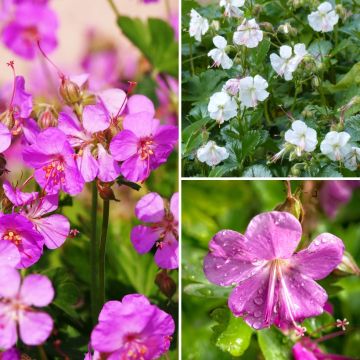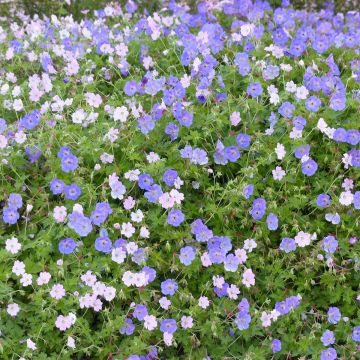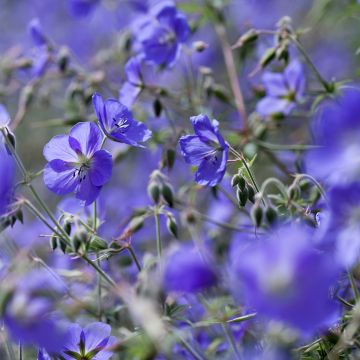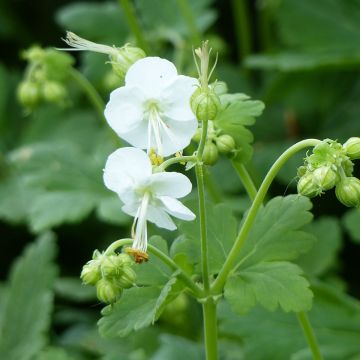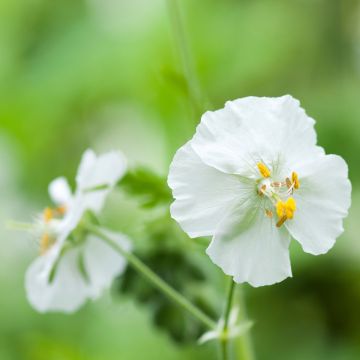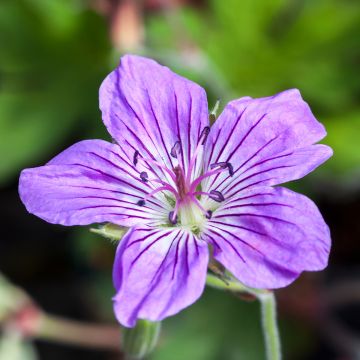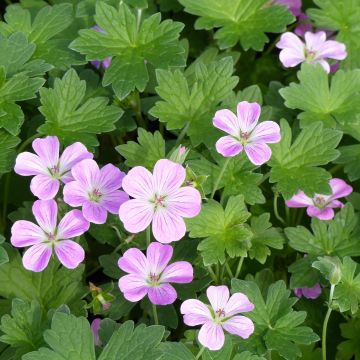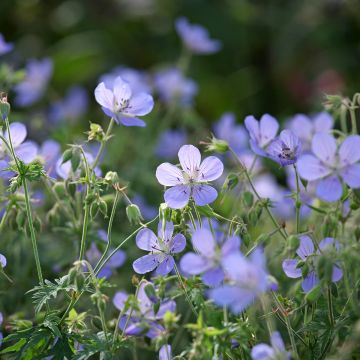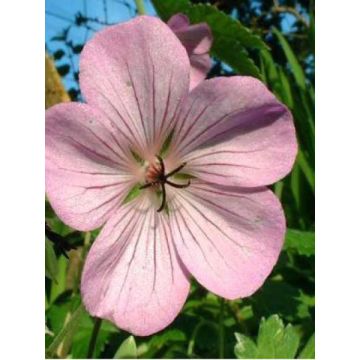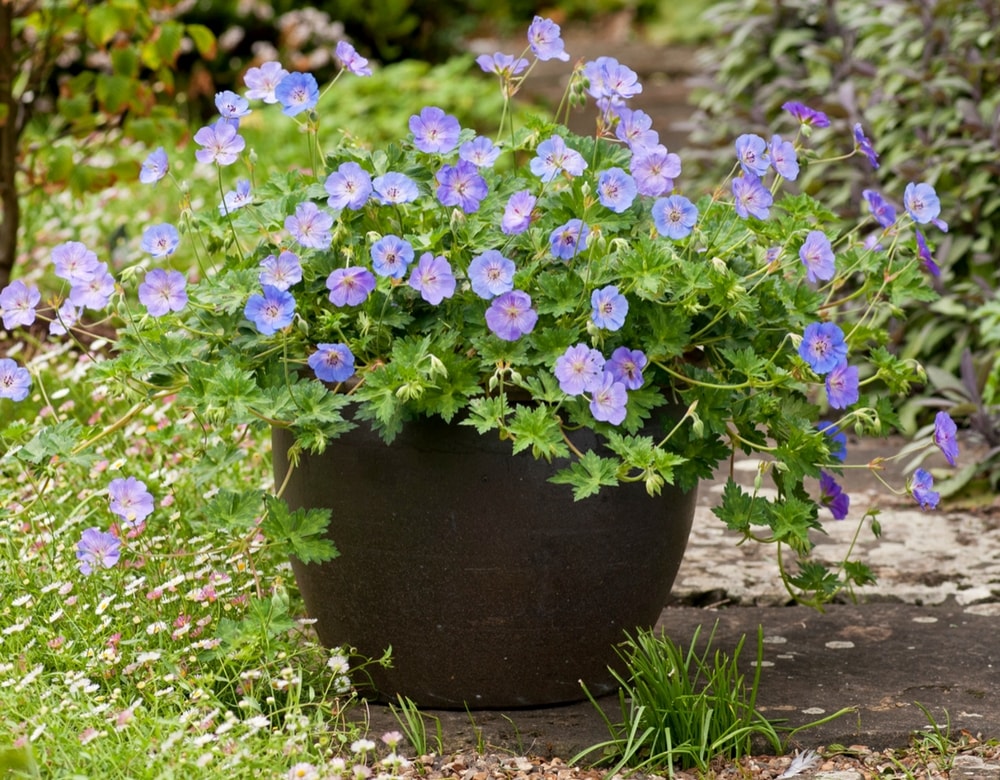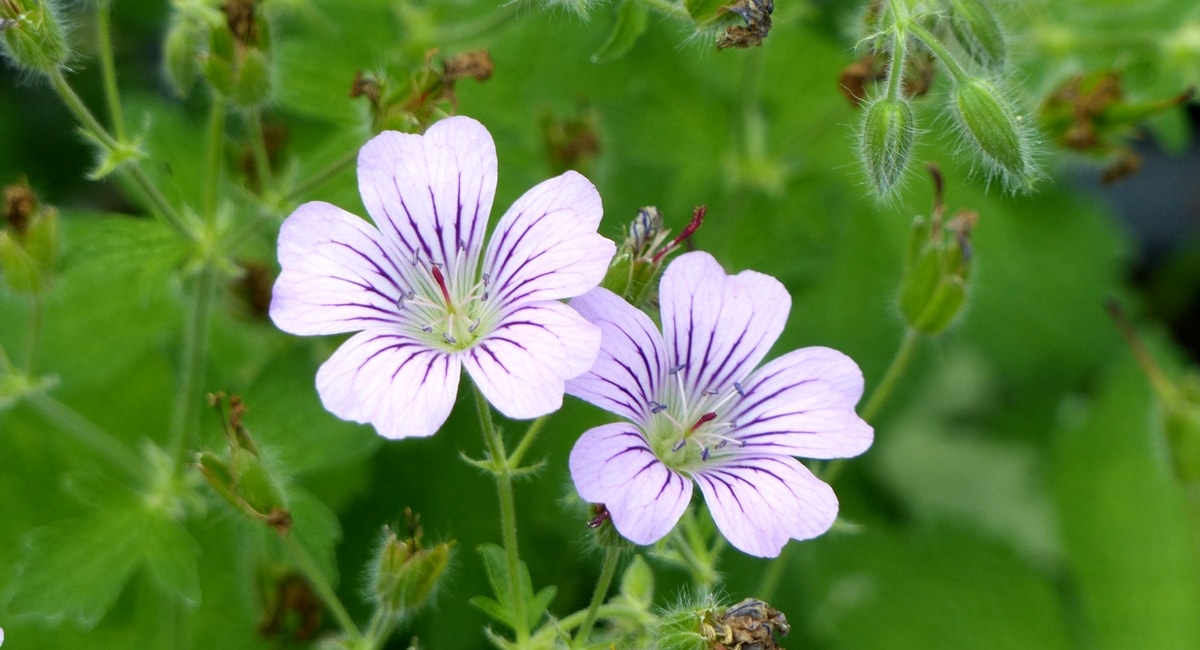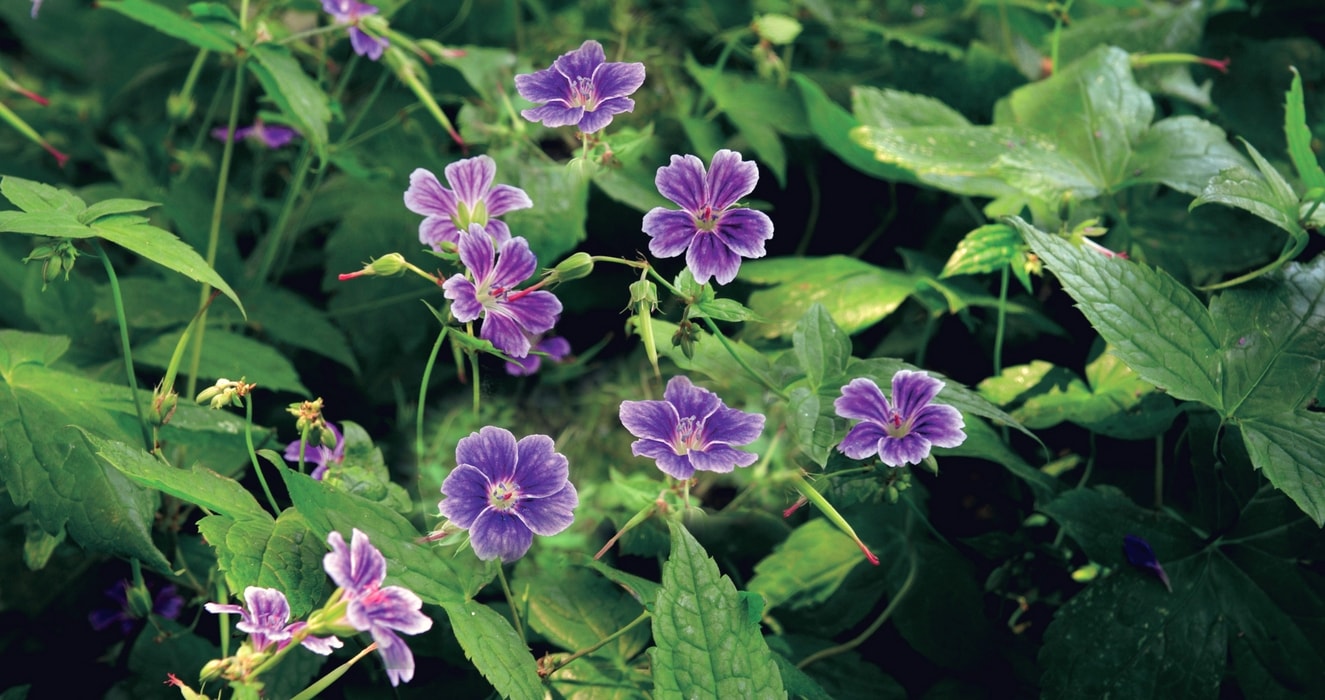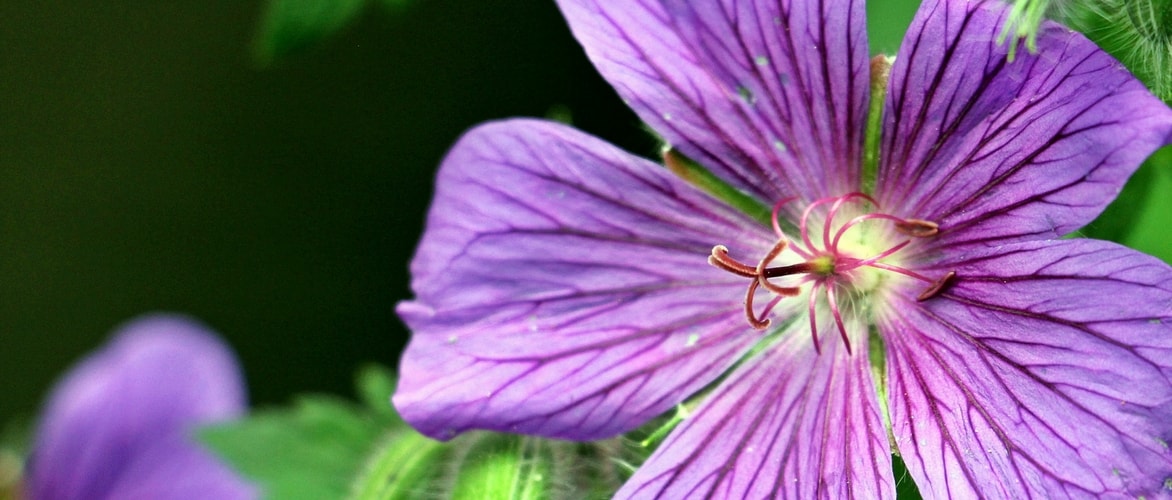
Hardy geraniums: Plant, grow and maintain
Contents
Hardy geraniums in a nutshell
- Geraniums charm us with their generous flowering, which can last for more than 6 months!
- Their flowers offer a wide range of soft shades: pink, blue, white, or mauve.
- They have superb foliage that is sometimes evergreen.
- They are excellent ground covers, with dense foliage that prevents weeds from growing.
- Depending on the varieties, they adapt well to pot cultivation, rockeries, or as ground cover at the base of trees and bushes.
- Easy to grow, they are robust plants that are not very susceptible to diseases.
A word from our Expert
Hardy geraniums offer a very long flowering period, which can last more than six months depending on the varieties! They bear delicate flowers and decorative foliage, sometimes evergreen. They form beautiful clumps or thick carpets of leaves. They are often confused with pelargoniums, which share the same common name, and whose vibrant flowering colours the window sills. This is unfortunate, as true geraniums have the advantage of adapting to cultivation in open ground, are completely hardy, and low-maintenance! They have a much more natural appearance than pelargoniums.
Geraniums are vigorous plants and rather easy to grow. They are not very susceptible to diseases and prevent weeds from growing… They are perfect perennials for achieving a flowering garden with a minimum of maintenance! Moreover, you can find a variety for every situation: for full sun or shade, dry or moist soils… And even for dry shade! Some geraniums will thrive in a sunny rockery, while others will be perfect in the undergrowth on cool soil. They integrate well into borders, make good ground covers at the base of trees or bushes, but can also grow in containers and thus brighten up balconies and window sills.
Botany
Botanical data
- Latin name Geranium sp.
- Family Geraniaceae
- Common name Hardy geranium, Cranesbill
- Flowering from May to September
- Height often 20 to 60 cm... and up to 1.50 m for Geranium maderense!
- Exposure sun or partial shade
- Soil type rich, cool but draining, without excess moisture
- Hardiness -20 °C for most varieties
The hardy geraniums comprise nearly 400 species and over a thousand horticultural varieties! They are generally perennial plants, sometimes annual or biennial. Their foliage is often deciduous, but can also be evergreen or semi-evergreen. They are quite hardy and vigorous.
Found on almost every continent, hardy geraniums have a wide global distribution. There are many species in the mountainous areas of temperate regions and in the eastern Mediterranean (Balkans, etc.). They are easily encountered in the wild in France, which explains their good hardiness. Thus, except for the Madeira geranium, they are well-suited to the French climate! The most common in the wild in France is undoubtedly the Herb-Robert geranium (Geranium robertianum), which you will find at the edges of paths or woods, or on old stone walls. Unlike the geraniums cultivated in gardens, it has an annual or biennial life cycle.
Hardy geraniums are often confused with pelargoniums, which are commonly found in window boxes. The latter are incorrectly referred to as “geraniums.” However, pelargoniums have irregular flowers (the upper and lower petals are not the same shape), are much less hardy, and their leaves and stems are much thicker. They mainly originate from South Africa, while perennial geraniums are found in temperate zones!
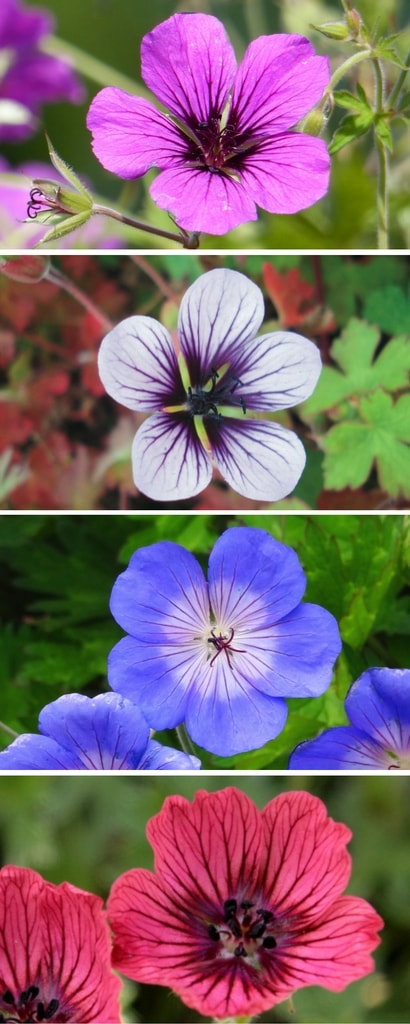
Hardy geraniums offer a beautiful range of colours! From top to bottom: Geranium ‘Patricia’, Geranium ‘Salomé’, Geranium ‘Rozanne’ and Geranium cinereum ‘Jolly Jewel Salmon’
The geranium belongs, along with pelargoniums and erodiums, to the family of Geraniaceae, which it has given its name, and which comprises nearly 800 species. Etymologically, geranium comes from the Greek geranos, meaning crane, because its fruits resemble the beak of a crane. This is also why this plant is commonly known as Cranesbill. Interestingly, the names of Erodium and Pelargonium refer, respectively, to the beaks of herons and storks!
Hardy geraniums form clumps that are more or less compact or mats of leaves, making them good ground covers. They sometimes grow in upright clumps, like Geranium psilostemon. Their height varies greatly: many varieties measure 20 to 30 cm tall, sometimes up to 60 cm… and even up to 1.50 m for the Madeira geranium (but that is an exception!)
The flowers of hardy geraniums are most often simple, with five petals. They measure 2 to 6 cm in diameter. This is a rather classic flowering, yet delicate at the same time. The petals are quite broad and sometimes notched at their tips. The flowers can be double, like those of Geranium himalayense ‘Plenum’, giving them a much more sophisticated appearance. Depending on the fineness of the petals, they can take on a star-like shape, like the Geranium ‘Catherine Deneuve’.
The flowers come in beautiful shades of pink, mauve, blue or white. They can also be dark, purple, like in Geranium phaeum. They are sometimes bicoloured: the centre is then a slightly different colour, either darker (even black, in the case of Geranium psilostemon), or lighter, creating a lovely contrast. They often have darker veins radiating from the centre. The flowers of Geranium versicolor are striking with their pronounced veins standing out on white petals, creating a lace-like appearance!
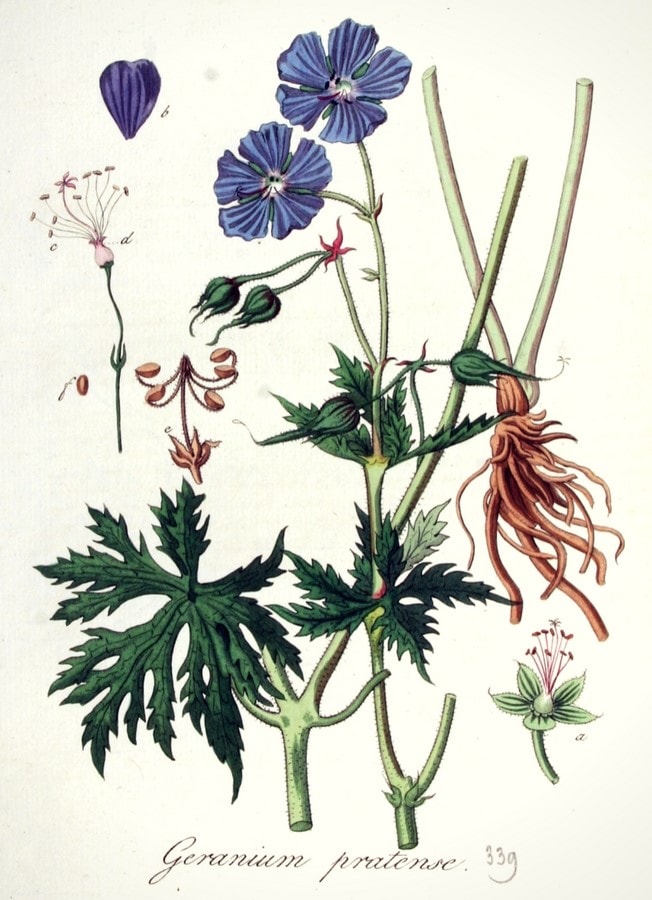
Geranium pratense: botanical plate
Hardy geraniums can flower from spring to autumn, depending on the varieties. They sometimes offer an initial flowering at the end of spring, followed by a second in late summer. This resurgence of flowering is encouraged by summer pruning. Some, like the geranium ‘Patricia’, can flower for more than six months!
Hardy geraniums have decorative foliage, often quite finely divided. The leaves are palmately shaped, with rounded or sharper and finer segments. Those of Geranium renardii are very rounded and not deeply divided, while those of Geranium sanguineum are deeply divided. They can be aromatic, as in Geranium macrorrhizum, and then release a lemony scent when crushed. They are sometimes villous and sticky, as in Geranium macrorrhizum.
Although it is green in most varieties, the foliage can also take on a very dark purple hue, as in Geranium pratense ‘Purple Ghost’. The leaves sometimes display stunning colours in autumn, red, orange or bronze. This is the case for Geranium macrorrhizum, Geranium wlassovianum and Geranium sanguineum.

The diversity of hardy geranium foliage! From left to right: Geranium maculatum, Geranium renardii, Geranium ‘Bob’s Blunder’ and Geranium nodosum (photo Benjamin Zwittnig)
Most varieties are deciduous, but there are also evergreen geraniums. This is the case for Geranium x cantabrigiense or Geranium cinereum. Others retain their foliage only in a mild climate and lose their leaves in the event of a harsh winter.
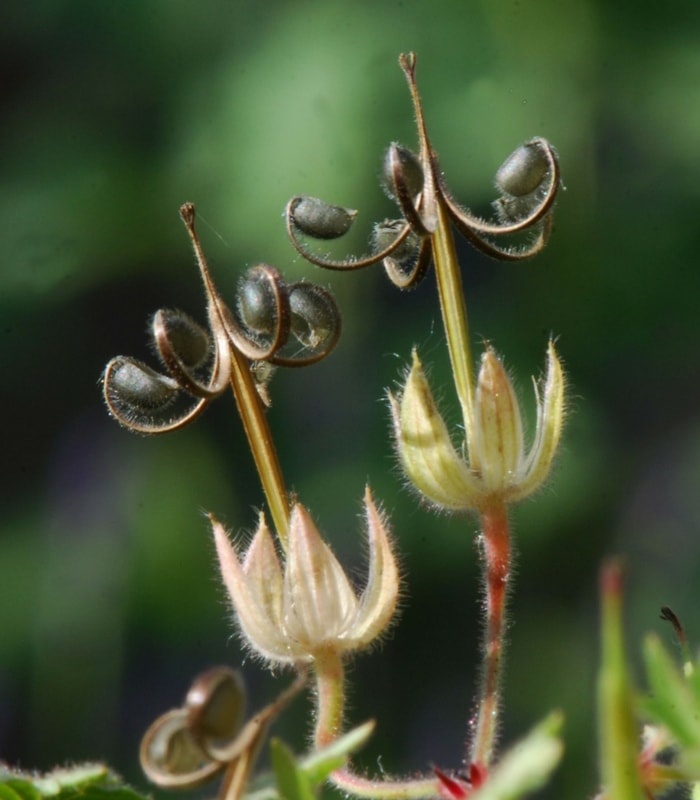
The fruits of Geranium rotundifolium (photo Pancrat)
The fruits of the geranium, very fine and elongated, have the shape of a crane’s beak. They are surprising because, at maturity, a tension system allows them to suddenly eject the five seeds they carry, up to several tens of centimetres!
Some varieties have rhizomes that allow them to spread. Geranium macrorrhizum owes its name to its very thick rhizomes. Others have a single central stump, which remains in place and does not sucker (only the stems spread to cover the ground). Some geraniums form tubercles, which gives its name to the tuberous geranium (Geranium tuberosum). They have the particularity of flowering in spring and entering dormancy in summer.
Read also
How to plant hardy geraniums?Species and varieties

Geranium Dragon Heart
- Flowering time July to November
- Height at maturity 60 cm
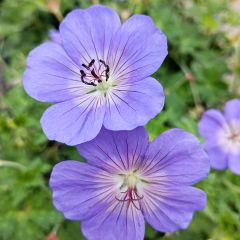
Geranium Rozanne
- Flowering time July to November
- Height at maturity 25 cm
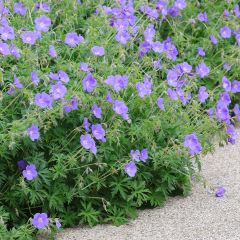
Geranium Orion
- Flowering time July to December
- Height at maturity 60 cm
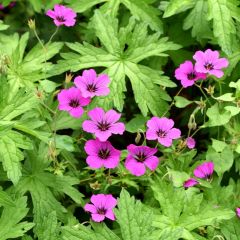
Geranium Patricia
- Flowering time July to December
- Height at maturity 50 cm

Geranium Johnsons blue
- Flowering time June to September
- Height at maturity 50 cm
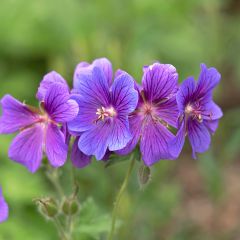
Geranium magnificum
- Flowering time July, August
- Height at maturity 60 cm
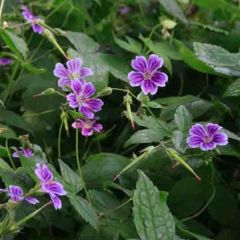
Geranium nodosum Clos du Coudray
- Flowering time July to October
- Height at maturity 50 cm
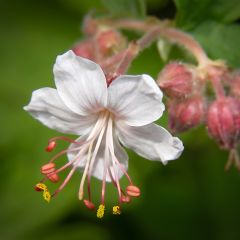
Geranium macrorrhizum Spessart
- Flowering time June, July
- Height at maturity 30 cm
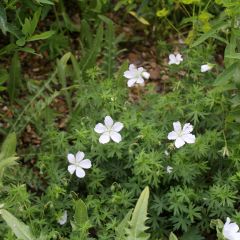
Geranium sanguineum Album
- Flowering time July to October
- Height at maturity 25 cm
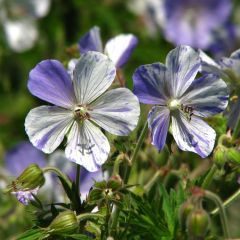
Geranium pratense Splish Splash
- Flowering time July to September
- Height at maturity 50 cm

Geranium psilostemon - Armenian Cranesbill
- Flowering time July to September
- Height at maturity 80 cm

Geranium maderense
- Flowering time June, July
- Height at maturity 1,20 m
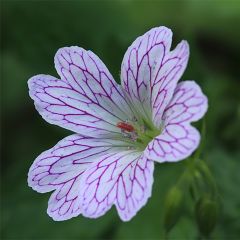
Geranium versicolor
- Flowering time June, July
- Height at maturity 30 cm
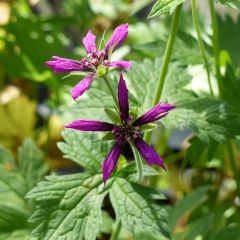
Geranium psilostemon Catherine Deneuve
- Flowering time June to September
- Height at maturity 50 cm

Geranium Ann Folkard
- Flowering time July to November
- Height at maturity 40 cm
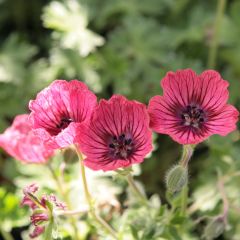
Geranium cinereum Jolly Jewel Salmon
- Flowering time July to September
- Height at maturity 20 cm
Are you finding the choice complicated? Let yourself be guided by our advice sheet: “Hardy geraniums: how to choose them?”
Discover other Hardy Geranium - Cranesbill
View all →Available in 0 sizes
Available in 0 sizes
Available in 3 sizes
Available in 2 sizes
Available in 1 sizes
Available in 1 sizes
Available in 1 sizes
Available in 1 sizes
Available in 2 sizes
Available in 1 sizes
Planting hardy geraniums
Where to plant?
Most hardy geraniums thrive in sun or partial shade. The species best suited for shaded areas are Geranium nodosum, which can even tolerate dry shade, and Geranium maculatum, which prefers more humid soil.
Hardy geraniums are rather undemanding regarding soil type. Generally, they favour fairly rich and humus-bearing soils that are relatively light. The soil should be well-draining but remain cool in summer. Avoid waterlogged areas, as hardy geraniums do not like excess water. They appreciate neutral or slightly acidic soils. Geranium sanguineum seems to be one of the most accommodating: it tolerates poor, dry, stony soils.
When to plant?
You can plant hardy geraniums in spring, after the last frosts, or in autumn.
How to plant?
We recommend enriching the soil with some compost. Maintain a distance of at least 40 cm between each plant to allow them space to develop properly. Plant compact geraniums, such as Geranium cinereum, more densely than those that spread and take up space (for example, the varieties ‘Rozanne’ or ‘Ann Folkard’).
- Place the root ball in a basin filled with water. This will help the plant establish.
- Dig a hole 2 to 3 times the size of the root ball, and add a few handfuls of compost or potting soil.
- Remove the plant from its pot. We recommend loosening the root ball a bit and gently untangling the roots, especially if they are pot-bound.
- Position the geranium.
- Replace the soil and gently firm it around the plant.
- Water.
Continue to water regularly in the weeks following planting. Your geranium will bloom within the year!
Pot planting:
You can plant your hardy geraniums in pots or window boxes. Some varieties produce long stems that will cascade over the edge of the pot! Feel free to plant other plants alongside them.
Start by preparing the substrate by mixing potting soil with a bit of sand. Choose a pot that is deep enough. Place clay balls at the bottom to allow for drainage. Add the substrate, then position the root ball. Cover with soil and firm down. Water.
To learn everything about planting hardy geraniums, check out our advice sheet: “How to plant hardy geraniums”
Read also
Pair hardy geraniumsMaintenance
Once established, geraniums require very little maintenance! They are low-maintenance plants that manage well on their own. Their dense foliage has the advantage of preventing weeds from growing!
Geraniums are resilient plants, rarely suffering from diseases or pest attacks. However, they can be affected by powdery mildew. This fungal disease is characterised by a white fluff covering the leaves and stems. It develops in shaded areas of the garden, during warm and humid weather, or when plants are too densely planted. Cut away the affected parts, avoid wetting the foliage when watering, and if necessary, treat by spraying sulphur. Also, be cautious of slugs, which tend to nibble on young shoots. Scatter ash around your plants to create a barrier. Geraniums can occasionally be attacked by the larvae of otiorhynchus and by sawflies.
If you have planted them in a pot, we recommend watering at least once a week, or a bit more during the summer. Allow the medium to dry out between waterings: excess moisture can cause the roots to rot.
Geraniums planted in the ground do not need fertiliser. Add a bit of compost in autumn, around the clump, especially if your soil is poor. If you are growing it in a pot, we recommend adding a bit of liquid fertiliser every two to three weeks.
How to prune:
In mid to late summer, once the flowering is finished, prune severely to rejuvenate the plant. Remove the faded stems and damaged foliage. This encourages the development of new vigorous shoots, more decorative foliage, and promotes a second flowering, while preventing the plant from self-seeding. Pruning the geranium also helps control its growth and keeps it more compact. You can also remove dead stems and leaves at the end of winter, cutting the plant back to ground level.
However, some geraniums, such as Geranium macrorrhizum, do very well without pruning.
Multiplication
Not all hardy geraniums propagate in the same way. Some techniques are more or less suitable depending on the varieties. Reserve sowing for botanical species; for horticultural varieties, prefer propagation by cuttings or the division for those that spread through their rootstocks or stolons.
Sowing
It is possible to multiply geraniums by collecting and sowing the seeds, but it is better to reserve this technique for botanical species. For horticultural varieties, the results are quite unpredictable, and there is little chance that the flowers will be identical to those of their parents. Some hybrids, such as ‘Johnson’s Blue’ or ‘Patricia’, are even sterile.
Geraniums (notably endressii, oxonianum and pratense) tend to self-seed easily! You can remove the faded flowers to prevent spontaneous sowing, or choose to let them self-seed freely. Collect the seeds by cutting the fruits when they are ripe.
You can sow the seeds at autumn, just after collecting them. The germination rate is higher when they are sown fresh, but it is also possible to store them for sowing in spring.
- Fill a pot with special sowing compost, then lightly firm it down.
- Sow by scattering the seeds on the surface.
- Cover with a thin layer of compost.
- Water.
- Place the pot under a frame, out of direct sunlight.
Continue to water regularly to keep the substrate moist. The seeds will germinate in spring. As soon as the seedlings have several leaves, you can repot them, then plant them in the ground once their root system is sufficiently developed. Depending on the different varieties, you will need to wait one to two years for the geraniums to start flowering.
Tuft Division
The method of propagation depends on the behaviour and morphology of the plant: those that spread by producing rootstocks or stolons are easy to multiply by division. The more compact ones (for example, Geranium cinereum) or those with a taproot are less suitable for this technique. In this case, propagation by cuttings is preferred.
The advantage of division is that it allows for easy production of new plants. The best time to divide geraniums is in spring, in April or May. Do this on average every four years to rejuvenate the clumps.
Start by digging up the clump. Then divide it by hand or with a spade, to obtain several clumps, each with enough roots. Dig a planting hole and add a few handfuls of compost. Plant them in their new location, then water.
For more information, check our advice sheet “Hardy Geraniums: How to Divide Them”
Propagation by Cuttings
You can propagate the geraniums in spring, around April. This is an interesting technique for varieties that do not lend themselves to division or sowing. Propagation by cuttings works very well for Geranium macrorrhizum!
Prepare a pot by filling it with substrate, then take a segment of the basal stem. Leave only one or two leaves on the cutting, remove the others and any flowers or flower buds. Plant the cutting, then gently firm it down to ensure good contact between the stem and the substrate. Water. Place the pot in a bright location but out of direct sunlight, at a temperature between 20 and 25 °C, and ensure that the substrate remains moist until rooting occurs. The cuttings root quickly, and the new plants can flower within the year!
Association
With its generous flowering and decorative foliage, the hardy geranium easily finds its place in a colourful mixed border, typical of English gardens! Its soft hues bring a natural and romantic touch. It pairs wonderfully with roses, delicately dressing their often bare base. The colours of the geraniums and roses harmonise perfectly! It will also reduce maintenance and the need for weeding at their base. Similarly, the hardy geranium is a good ground cover that adds colour at the base of trees and bushes.
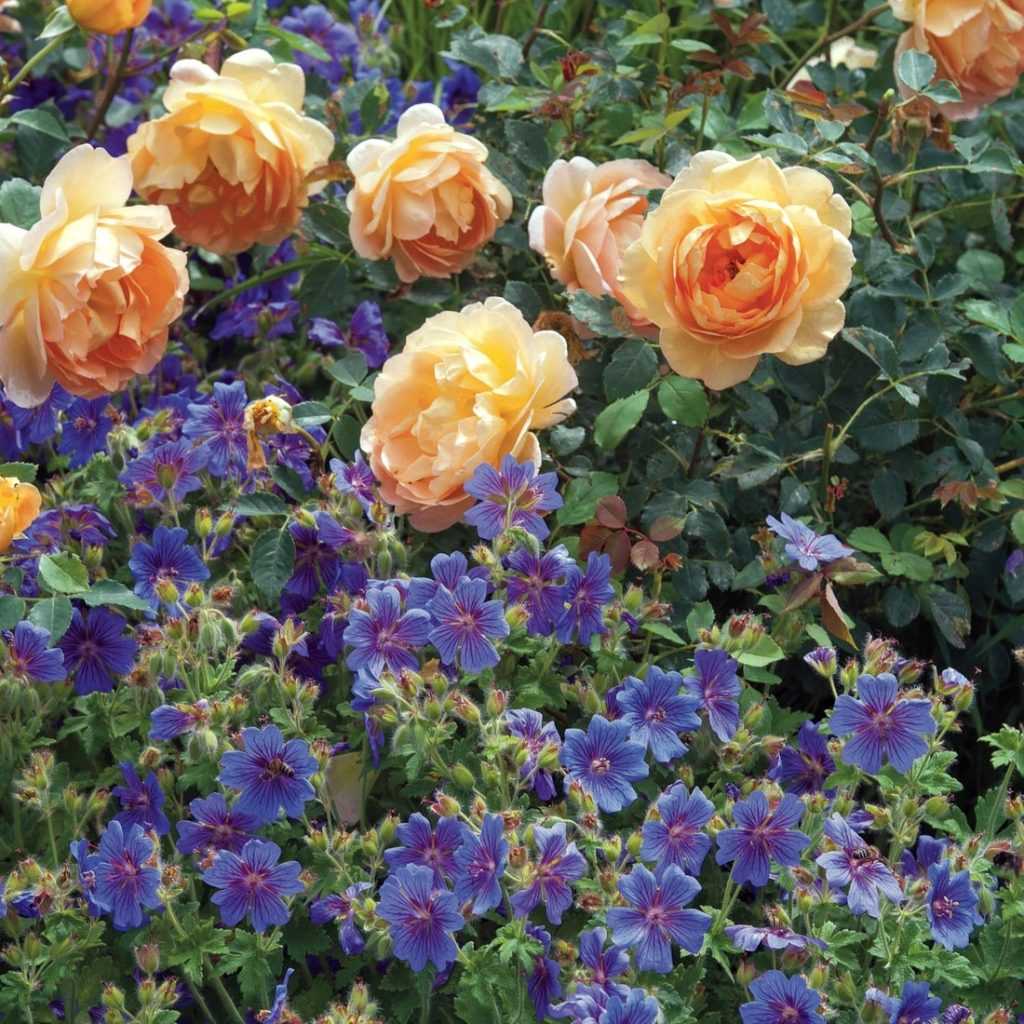
The rose ‘Lady of Shalott’ with the hardy geranium ‘Rosemoor’ (copyright Biosphoto Friedrich Strauss)
The hardy geranium has nothing to envy from the pelargonium, the “king of balconies”. Planted in a pot or window box, it beautifully colours window sills and terraces! Some varieties like ‘Azure Rush’ or ‘Ann Folkard’ have long stems that cascade over the edge of the pot.
The pink, blue, or white flowering of the geranium creates a romantic and delicate atmosphere. It is perfect for accompanying roses, but also for integrating into a flowerbed alongside astrantias, sages, stachys, or alliums. It can also be part of a cottage garden, with lush vegetation and soft tones. Its rather understated flowering and broad foliage will bring a very natural feel!
Depending on the varieties, geraniums are excellent understorey plants (e.g. Geranium nodosum) associated, for example, with ferns, while dwarf varieties like Geranium cinereum or Geranium dalmaticum are good rock garden plants, suited to sunny and drier conditions.
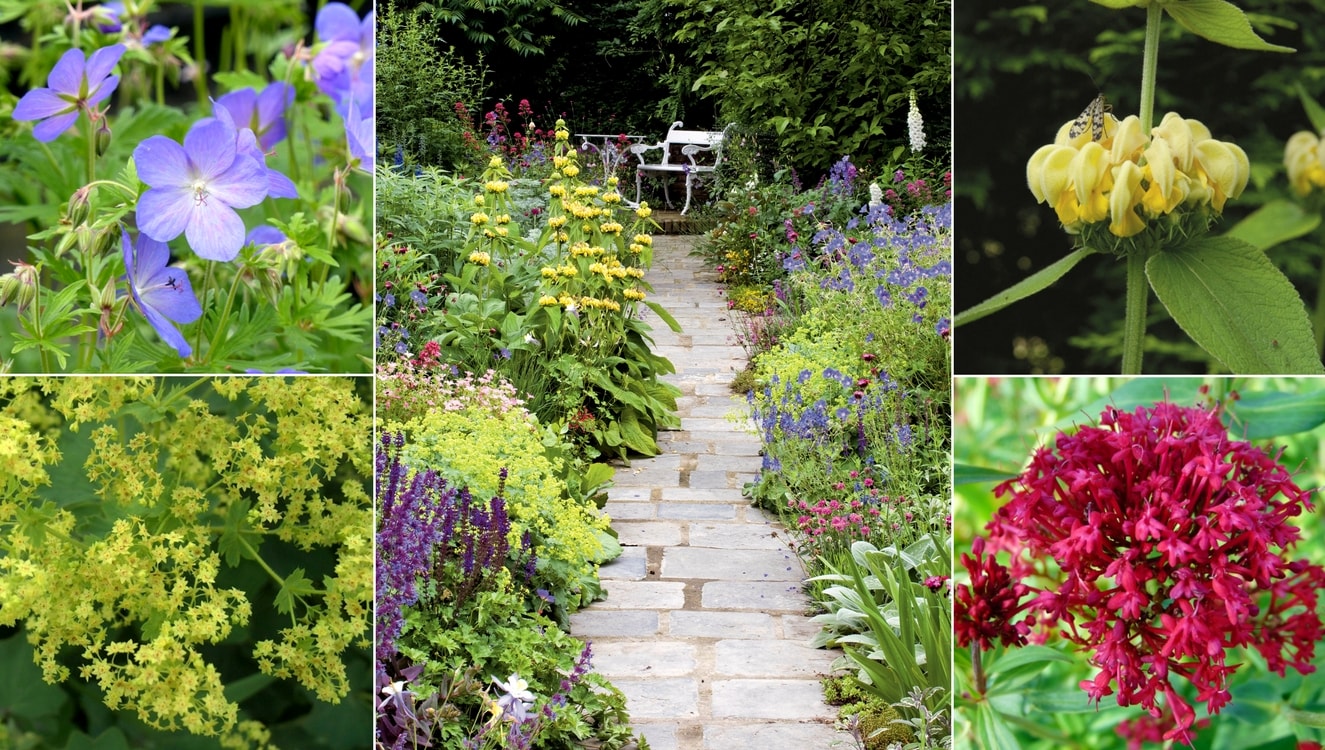
A colourful scene along a path with Geranium ‘Johnson’s Blue’, Alchemilla mollis, Phlomis russeliana, and Centranthus ruber (copyright GAP Photos Elke Borkowski)
… and many more ideas in our association sheet “Pairing Hardy Geraniums”
Useful resources
- The most beautiful range of hardy geraniums is with us!
- Our advice sheets: How to plant hardy geraniums?, How to divide hardy geraniums?
- Video – How to plant perennials?
- Video: How to prune and care for the ‘Blue Sunrise’ geranium
- An article by Didier Willery, published in L’Ami des Jardins et de la Maison (April 2014): We love all hardy geraniums!
- Francis Peeters talks to us about the ‘Dragon Heart’ geranium
- The website of Dominique Evrard, who has created the national collection of hardy geraniums
- Our advice sheets on the wide range of this perennial: 8 hardy geraniums for beginners; hardy geraniums that tolerate drought; 8 hardy geraniums with blue flowers; 9 hardy geraniums with pink flowers; Hardy geraniums: discover colourful foliage varieties to enhance your flower beds
- Discover Geranium ‘Rozanne’ in Olivier’s video and Geranium macrorrhizum
Frequently asked questions
-
The leaves of my geranium are covered in a white fluff!
Your geranium is affected by powdery mildew, a fungal disease. Cut off the damaged leaves and stems and treat by spraying with sulphur. Heat and humidity promote this disease: avoid confined or overly humid environments, and try not to wet the foliage when watering.
-
Should I add fertiliser?
In open ground, it is not necessary to add fertiliser. We recommend adding a bit of compost at planting time, and possibly adding more in autumn around the clump, especially if your soil is poor. In pots, you can apply liquid fertiliser every two to three weeks. Use a balanced fertiliser that is not too high in nitrogen.
-
My geranium lacks vigour, it is struggling and not shooting.
Prune the clump severely after flowering. This encourages the emergence of new foliage and more vigorous shoots, and may allow for a second flowering. Also, divide your young plant to rejuvenate it. If necessary, you can add a bit of fertiliser.
-
My geranium is wilting in the centre of the clump.
Over time, some geraniums spread outwards but tend to hollow out in the centre of the clump. They should be divided regularly, on average every four years. This helps to rejuvenate the plant and restore its vigour.
- Subscribe!
- Contents































